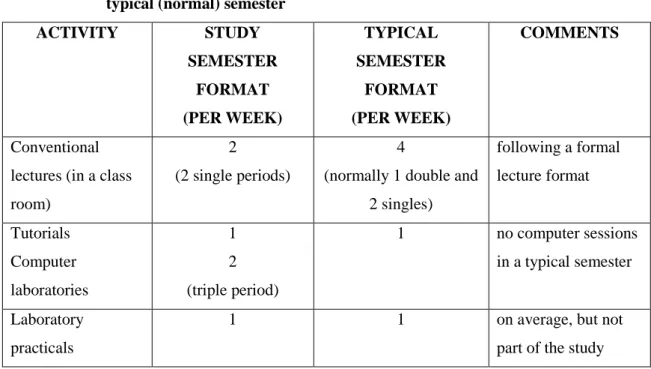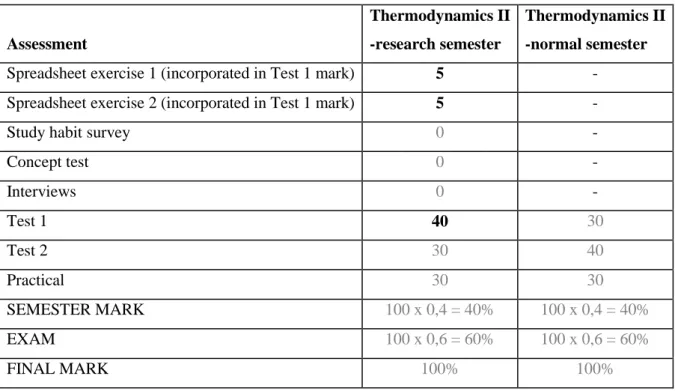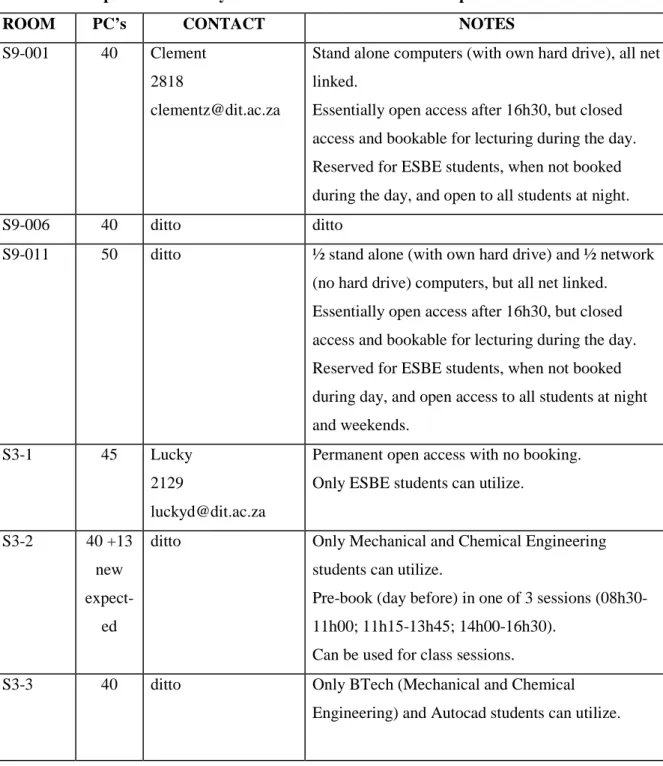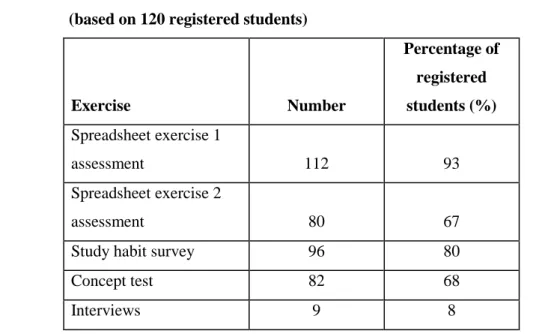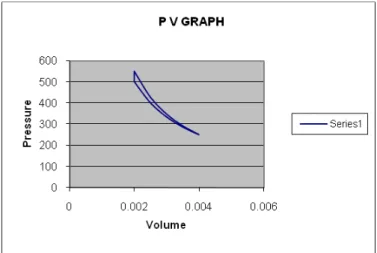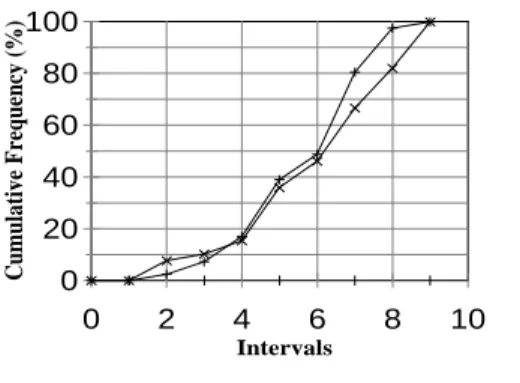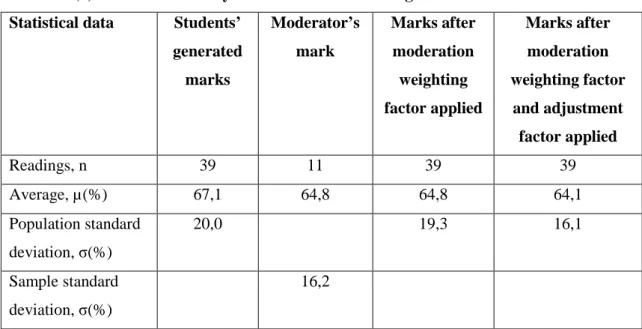The second part of the course was handled in the typical manner of conventional lectures. This also leads to the external validity, mentioned in chapter 3.2.2, of the data revealed in the interviews and whether they can be used to generalize the opinions realized from the data.
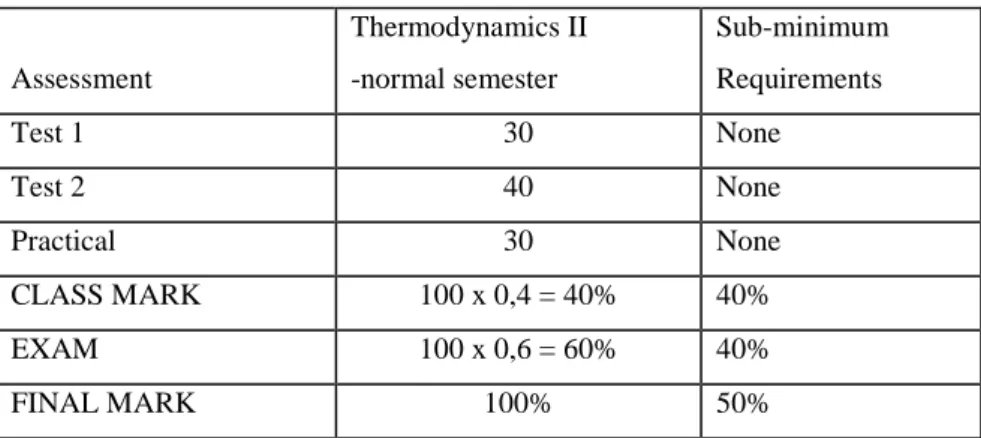
Own library notes
This was one of the questions asked in the interview, question 4 as seen in Appendix I. It was highlighted in Chapter 2.3.2. Application of the theory and the use of previous papers are two excellent. Another source available in the library is the collection of the entire past examination papers.
The second half of the semester was completed in the normal manner of lectures as previously mentioned. Many of the observed problems picked up from the Researcher assessing the assignments during moderation were discussed in Chapters 4.1.7.2 and 4.1.8.2.
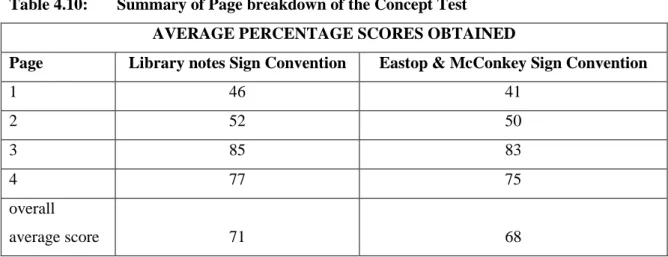
Own reference book
- Introduction
- SAQA and the NQF
- The changing education background
- OBE and the NQF
- HEQF and ECSA
- The new National Funding Framework
- Departmental pass rates and issues of concern
- Overview of assessment in Thermodynamics II
- Lecturing style
- Traditional teaching methods
- Lectures as a learning environment
- The students
- Who are they
- Practical experience
- Facilities and resources available to them
- Learning Theories
This is higher than typical current pass rates, which have fallen in recent years. They have different expectations of college and campus life, and are often disappointed by the reality of the situation.
Learning
- Approaches to learning
- Deep and surface learning
- Strategic and non-academic
- Learning styles and inventories
- Learning cycles
- Motivation
- Constructivism and active learning
- Study Habits
In the same study, other students "skated along the surface of the text" (as cited in Ramsden, 1992, p.41). Of the learning styles mentioned, only the inventories of Entwistle and Vermunt "attempt to develop a model of learning within the specific context of higher education" (Coffield et al., 2004a, p.92).
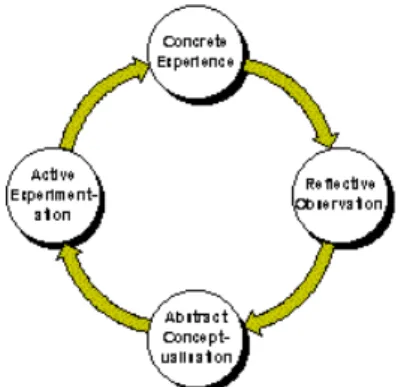
Delivery
- Lectures
- Text books
- Use of library
- Computers
- Dialogic teaching
- Group work
- Thermodynamics
- Learning the language for an engineering topic
- Laws of thermodynamics
- Other problems related to thermodynamics
- Conceptual problems
- Use of resources
- Mismatch of preferred learning style and delivery
- Mismatch of preferred learning style and lecturers delivery style
Neglecting any of the components mentioned would almost certainly lead to a failure in this subject. In the evening there are additional problems, some of which will be highlighted in Chapter 4.
Assessment
One of the most important components of assessment is feedback on assessments to students (Ramsden, 1992, p.99). Therefore, a number of new assessment tools for this topic have been devised and used for this research project, namely peer assessment (discussed in the next section) and the concept test (quiz), described in Chapter 3.10.
A Case Study
Second, case study research has often been considered "soft" (Gillham, 2000, p.10, Denscombe, 2003, p.39, Yin, 2009, p.21) as it lacks the rigor of other types of research. social science research, partly because of their qualitative nature, but also because the rigor of the approach may not have been met. Thus a case study was chosen as it was a limited example, Thermodynamics II class for Semester 2, 2006.
The paradigms, A theoretical framework
- The Positivist Paradigm
- The Interpretivist Paradigm
- The research activities compared under the research paradigms
- Triangulation
Within this paradigm, the epistemological standpoint of the researcher is seen as an external neutral observer, i.e. comparing the results of the students in the Research Study with the results of previous semesters is quantitative and therefore falls within this paradigm.
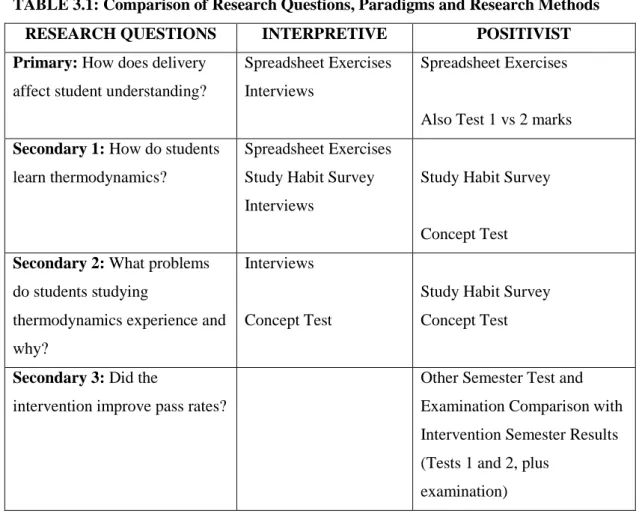
The research procedures
Although limited to the first eight weeks of the semester, the nature of the tasks was also limited. Certain parts of the theory have been chosen for this project, which form the backbone of almost all thermodynamic analyses. The remainder of the semester, approximately seven weeks, was taken up by normal lectures, interspersed with regular teaching periods, as shown in the second column in Table 3.3.
The scope, limitation and exclusions
53 A further aspect of the study was interviews, "one of the main tools for data collection in qualitative research" (Punch, 2005, p. 168).
The intervention mark allocations
A semi-structured interview approach was chosen, the details of which are covered in Chapter 3.11.2, using a standard set of questions (Appendix I). This can be seen in Table 3.4 below (the intervention figures are in bold), while the rest of the figures (shown in grey) are the same as for a normal semester.
Assessment of the students
The grades analyzed in Chapter 4.5 were derived from class tests and an end-of-semester exam. A dependent t-test, detailed in Section 4.5.2, was conducted to compare the results of Test 1 and Test 2. Each component of the Study Habits Survey discussed in Section 3.9 was analyzed separately to explore students' approaches to their studies and performance in the course.
The computer laboratories
It was thus fairly controllable in terms of access, located close to the Mechanical Engineering Department, large enough to accommodate the class in a single location, and transparent via Ethernet to the researcher's computer to access it outside of contact hours. These two labs, although in the same building, were located at a distance from the Mechanical Engineering Department, large enough to accommodate the class, but in two locations and, for some unknown reason, not transparent via Ethernet to the researcher's computer to get access to it outside the contact hours. However, it was permanently connected to the Internet, which caused several problems, discussed in Chapter 4.1.1.1.
The computer spreadsheet exercises
They were also informed about the moderation protocol in the leaflet, which accounted for 10% of the completion. To assess projects fairly, validly and consistently (Qualifications Authority of South Africa, 2001, pp. 16-17) a scoring rubric was developed, discussed in Chapter 4.1.5 (see Appendices E and F) and exposed. at the beginning of the project, both in the computer labs and outside the thermodynamics lab. On the day of assessment, each group had to sign a declaration form (see Appendix G), declaring that the completed work was theirs.
The study habit survey
As mentioned in Chapter 1.7.1, the class racial divide was fairly typical of the national racial divide, except that there are more Indians in KZN due to immigration history. The fourth item in this section was to determine the highest qualification of the students' parents or guardians. This section was included in an attempt to find out how much use students made of the library.
The concept test
The interviews
However, the researcher is also aware of his positivist background, which may influence his interpretation of the data. Students were therefore given space during the interview to deviate from the topics if a new area of interest arose and also to ask questions of the researcher. However, a beta version 2.2 was available from the program's author and this immediately eliminated some of the problems.
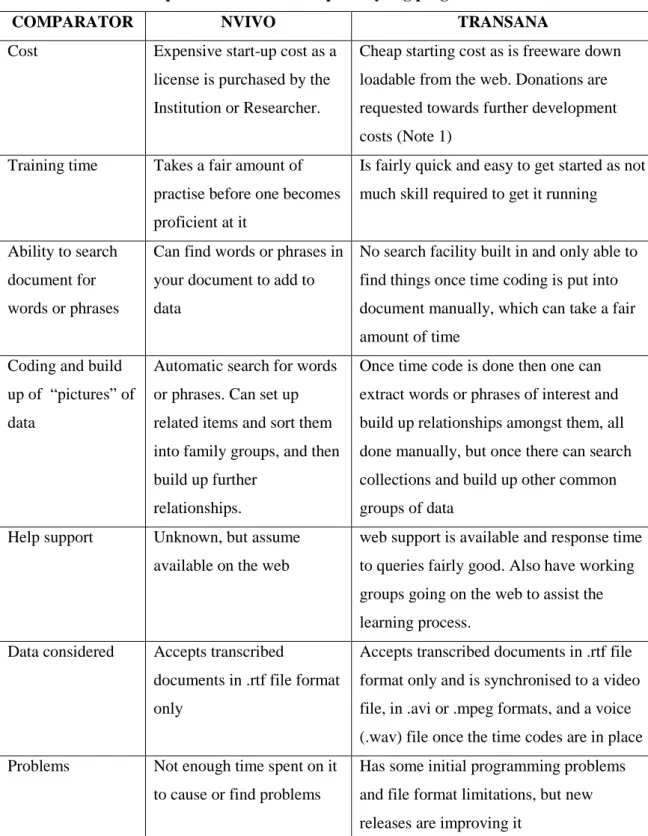
The Computer Spreadsheet Exercises
- Group allocations and filenames
- The assignment handouts
- Computer session attendance
- Computer related Problems
- The Assessment Rubrics
- The sample problems
- Spreadsheet Assignment 1 - Processes and Closed Cycle Analysis
- Spreadsheet Assignment 2 - Non-flow and Steady-flow Energy Problems and
Viruses - this became one of the major problems and caused a lot of wasted time in the two computer labs. Of the 39 assessed tasks, only eight responses were graded into rubrics, as shown in Appendix E. The researcher believes that the assessment tasks were generally not well understood.
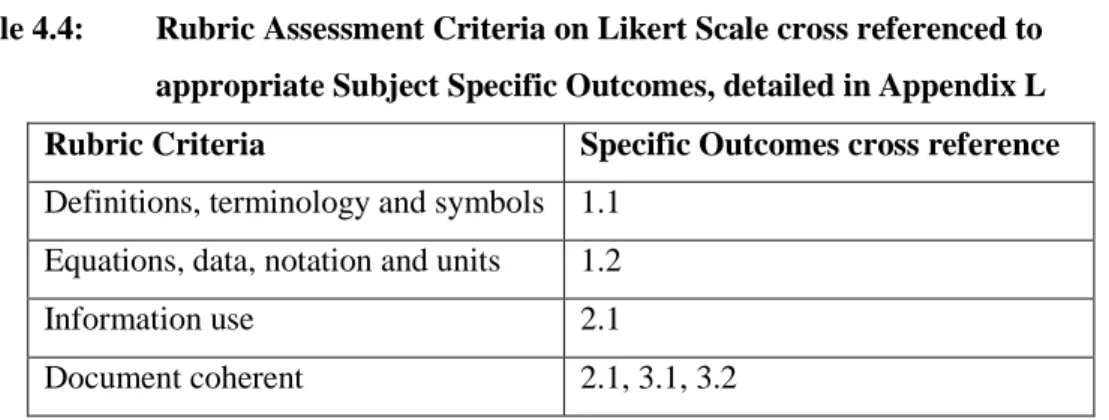
The Study Habit Survey
- Personal Information
- Information Exchange
- Library Use
- Subject Specifics
- Practical Experience/Exposure
- Study Techniques
Since the study habit survey was divided into six categories, as discussed in chapter 3.9, the data analysis will be discussed in each category. In this part of the student study habits survey, students were asked if they had worked before entering the institution. Of the 57 valid entries in this category, 72% indicated that they had worked in groups, but only 46.3% of them passed.
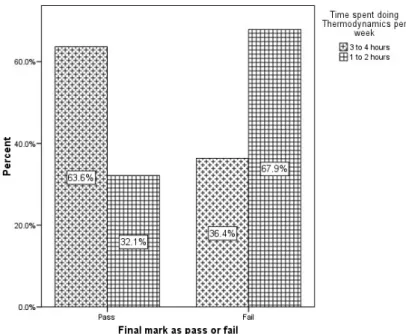
The concept test
- Overall summary of the test
- The Choice of Sign Convention
- Summary of Page Analysis
The questions also tested students' knowledge and understanding of the first law of thermodynamics. The similarity of the results was expected, since the answers were more based on the combination of the first law. Here too, the application of the first law of thermodynamics must be understood and applied in the analysis.
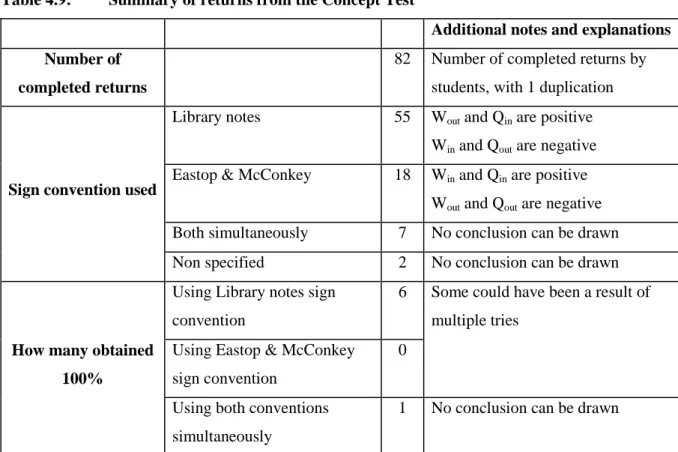
The Personal Interviews
- The Choice of Students for the Interview
- How do students learn thermodynamics
- Student problems experienced whilst studying thermodynamics
- Reliability of intervention and previous semester test 1 and test 2 scores
- Comparison of intervention semester test 1 and test 2 scores
- Analysis of differences between tests 1 and 2 in the intervention semester
- Comparison of previous and intervention semester test 1 and test 2 scores
During the listening and collection of interviews, seven themes known as “Collections” were created in Transana, the first step of the process as mentioned in section 3.11.3. This part of the interview is directly related to sub-question 2, which is shown above in chapter 2.4.1 and in table 3.1. Because of grouping, the people you group with and problematic… communication between students.
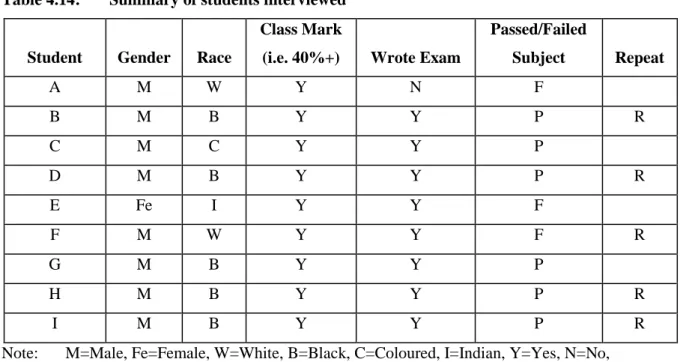
147
Summary of Primary Question
- Lectures, Tutorials and the Computer Intervention
- Text books and Library use
Yes, I think it has an advantage when it comes to understanding some things, sir”. Several interviewees said they had received copies of the library notes and used them extensively. There are also copies of the recommended books in the library, but Student C indicated that the problem with the library was the availability of the recommended books, especially since their use has also spread to other classes of students studying thermodynamics.
Sub-Question 1 – How do students learn thermodynamics?
As indicated in Chapter 4.2.4, the study times given in the literature vary from about ten to thirty hours per week. The fact that several groups were willing to reassess task 2, described in chapter 4.1.8.4, also showed that they were interested in the process. Regarding research techniques, specifically note-taking introduced in chapter 2.1.8 and discussed in chapter 4.2.6, this was investigated both in the interviews and via the study habits survey.
Sub-Question 2 – What problems do students studying Thermodynamics experience
- Subject related problems
- Other problems
There were some problems during the peer assessment, also mentioned in Chapter 4.1.7.2 and 4.1.8.1, although they did not hinder the process. 158 One of the most fundamental problems, highlighted in Chapter 2.4.1 and discussed in Chapter 2.3.1, is the conceptual nature of Thermodynamics. As mentioned in Chapter 4.4.2.4, students often initially do not see a need for Thermodynamics and are demotivated from the start.
Sub-Question 3 – Did the intervention improve pass rates?
This was emphasized in the lecture specifically designed to raise students' problems in any aspect related to assignments or tables, as detailed in Chapter 4.1.2. This has been increasing in recent years, as seen in the statistics in Appendix V. A further test, a Tukeys Post Hoc Test, detailed in Chapter 4.5.4, was done confirming the result mentioned above, that there was little change in test scores between semesters.
Limitations of the study
Since the majority of students indicated a preference for visual learning, as previously discussed in Chapter 5.2, this could have helped students better understand the theory.
Conclusions
While the learning outcomes of the course are well documented in Appendix W and circulated at the beginning of the semester, learning. 166 outcomes of the different learning processes used in the study could be more precisely exposed to the students. Also, an analysis of the learning environment and processes, together with problems that might arise and possible solutions, may have reduced the problems that did arise.
Questions for further investigation
- Teaching/Learning
- Library
Newbury Park: Sage Publications, Inc. Retrieved October 31, 2009, from http://cipd.co.uk/sublects/manddev/general/lrngstyles.htm. Not another inventory, rather a catalyst for reflection. http://www.vark-learn.com/documents/not_another_inventory.pdf. 2006) Learning styles again: VARKING up the right tree. Paper presented at the Proceedings of the 2002 American Society for Engineering Education Annual Conference and.
Interview Schedule
